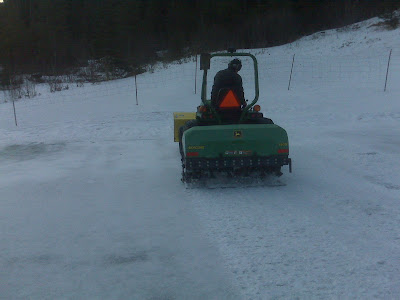 ICE REMOVAL TECHNIQUE
ICE REMOVAL TECHNIQUEIn previous years we have had great success with ice removal utilizing mechanical techniques. The weather does need to assist with this ice removal technique as it requires a "chinook" or warming winds that frequently flow through our valley in winter. Due to our north facing location on the side of a mountain and very minimal sunlight, typical techniques such as the application of dark or black sand to green surfaces, letting the sun warm the surface, placing green covers over the ice or risk using ice melt products are all useless. Therefore mechanical processes are required. And fortunately or unfortunately with have come up with a system that is both quick and effective during a warming period.
In late November of 2011 warm weather, melting snow and rains contributed to the formation of an ice layer on all of the greens. 1/4" to 1/2" of ice formed and was added to during rain events in December to create a 1/2" to 1" layer. Just prior to 45 days of ice cover, in early January 2012, warm weather allowed us to begin with our process. +7C daytime temperature proceded by +5C or better night allows the ice be workable. We use a John Deere 1500 fairway aerator with solid tines to fracture the ice loose from the evergreen turf cover that is laid over the greens in the fall of each year. These ice chucks are then pushed aside using a Toro Sandpro blade with a leading rubber edge on the blade itself. Utilizing two Toro Sandpros we eliminate the need for 6-8 staff with shovels. Fortunately having the evergreen covers in place prior to winter allows us to work the ice as needed as the ice breaks away from and slides off the cover well. Without covers the turf would be fully encased within the ice and would deem the ice virtually unworkable. Within 45 minutes to 1 hour we can aerate the ice on a green, clear it completely off and have a green breathing again. To date we have been able to clear 12 greens free of ice due to two warming periods early in January at the 42 day and 47 day period. We have previous experience in dealing with turf that has been under ice for 45, 60, 90 and 120+ days. As the covered period extends it greatly increases the likelihood of stressed turf come spring time.
The photos show the process beginning with aeration on green #8. We push the ice chucks aside as shown on green #14. The final look of the green with the cover still intact is shown on green #2. The plugs in the photo were taken from low areas of greens #7 and 11 and have greened up well despite having been covered under an ice layer for 43 days. This provides us with some level of confidence that the turf now has a good chance the rest of the winter on the greens we have cleared. Please do not hesitate to contact us about these processes if you are interested. If we can help others faced with these types of conditions we are more than happy to assist where possible.



